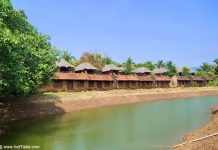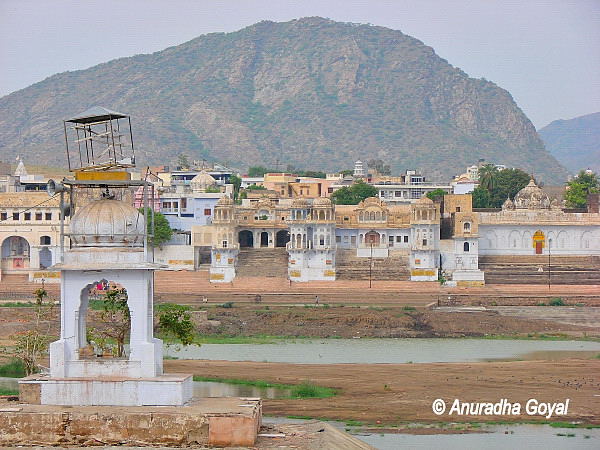Indic Academy and Bharat Adhyayayan Kendra, BHU came together to organize a first of its kind Indica Yatra Conference on 15-17th November 2019. The conference was held at the prestigious Banaras Hindu University, Varanasi. It aimed to bring limelight to the ancient Indic tradition of Travel. Including the concept of Tirtha yatra i.e. pilgrimage from the scholarly lens. It also aims to look at how ancient traditions can be adapted for modern times to promote travel and tourism in India.

Inauguration – Indica Yatra Conference 2019

Dr. Vijayshankar Shukla from Indira Gandhi National Center for Arts, who has extensively traveled across India shared insights on how historically Tirtha yatra (Pilgrimage) along with Utsava (festival) & Sthala Mahatmya (Local legends) evolved through the fusion of Vaidik and Shakta traditions.
Dr. Nagaraj Patauri, Director of Inter-Gurukula University stressed the need to explore travel in Indic literature. He urged to explore Dootakavya literature and ancient travelogues to explore ancient Indian pilgrimage much better.
Dr. Sadashiva Kumar Dwivedi from Bharat Adhyayan Kendra, BHU welcomed the audience to the holy city of Kashi. Sharing the perspectives on different Mandala-based principles that have led to multiple pilgrim circuits within the epic city. Including the famous Panch Kroshi Yatra.
Videos of Indica Yatra Conference 2019
You can virtually attend the conference by watching select videos of the presentations:
For your reference, read – Call for Papers for the conference
Yatras of Braj & Vaishnavism
In the focused session, on Braj Mandala and Vaishnav pilgrimage, Paridhi David Massey from Ashoka University shared her research insights. On how the British Colonial fraternity viewed the temple of Braj from a condescending perspective at one end to a very sympathetic and patronizing attitude at another end.
Sneha Nagarkar showcased her research from multiple texts from the medieval period. Highlighting how the key deities of Braj Yatra evolved over time from Vishnu to Krishna and Yamuna to Radha.
Sushant Bharati from the Archaeology Department highlighted the contributions of Narayana Bhatta. A medieval-era Telang Brahmin from Madurai whose deep study of scriptures was instrumental in relocating the lost places associated with Lord Krishna.
Dr. Shantanu Dey from Ramakrishna Mission shared perspectives on Mayapur. The traditional Vaishnava center of Bengal lost its significance to Navadwipa with the modern wave.
Yatras of Deccan & Saurashtra
Shashikant Ji shared insights about the Kootuva folk tradition of Karnataka. Where entire villages live through the immersive experience of Mahabharata. Celebrated with many local twists like Draupadi recalling Rama as a brother. The traditional way of recitation of Mahabharata involves major performances by local villagers on lesser-discussed perspectives of Mahabharata.
Dr. Varada Sambhus took the audience through the famous Varkari sect’s pilgrimage. Where women participate with complete autonomy and assertiveness. She made a brilliant point on how the neo-feminist movement views women’s movement through a binary construct of feminism popular in the western world. And fails to capture the essence of the strong powerful women of rural India.
Chinar Balasaraf presented the cultural mapping of the town of Pandharpur, especially during the annual pilgrimage.
Read More – Times of India Coverage of the Conference
Dr. Prachi Moghe took the case of Khandoba tradition. To highlight the importance of pastoral nomadic communities who are often the major patrons of similar folk gods.
Monish Shah threw light on Mumbai’s little-known pre-colonial ancestor – Sopara which was considered a major pilgrim center as per Jain texts. It is also being recognized with legends of Parshuram as well as Bodhisattva Surparaka.
Dr. Y P Singh, Director – Ayodhya Research Institute took us on World travel of the Ramayana story. From Iran to Indonesia through the images he has collected from his own travels to these sites.
Dr. Sadashiv Dwivedi spoke about the Sthal Puran of Kashi. Introducing the audience to the Kashi Mandala and its prominent pilgrimage routes.
Yatras of Western India

Divya Prasad shared the lesser-known folk traditions of Himachal Pradesh. Where the legends of gods and goddesses are celebrated akin to day-to-day human emotions. She shared a unique tradition called Bharta, which involves sharing an autobiography of Devata given by themselves.
Vinayak Pandey talked about the pilgrim circuits of Shekhawati involving the unique deity Khatu Shyam aka Barbarika of Mahabharata whose stand to fight for anyone who’s on the losing side irrespective of righteousness cost him his life in hands of Krishna. The beautiful mansions built by the highly successful merchants of the region are explored by French Universities as Coursework. Yet are largely overlooked by Indian tourists.
Yatras of Dakshina & Kalinga
Akshay Krishna from Amritha University talked about little known Ramayana trail of Kerala at the Indica Yatra Conference. Local tribal communities have indigenized the tales of Ramayana. Especially around the stay of Sita with Lav & Kush and celebrating the legend. With many places like Amritsar in Punjab, Bithoor in UP & Avani in Karnataka, it indicates that the popularity of the epic led to a deep internalization in local legends in every region of the subcontinent.
Shivashankar from Vision India Foundation shared the tales of an ancient but unique tradition of Tyagaraja. In which Shiva is worshipped in an idol form instead of a typical Linga form.
Aishwarya Mohan brought perspectives on the temples of Malabar which were destroyed by Tipu Sultan in the acts of religious persecution. Many of these temples are yet to be restored to their former glory.
Prateek Pattanaik a 19-year old Engineering student amazed the audience with his detailed scholarship on Chauttisa the musical traditions of pilgrims coming to Jagannath temple.
Ms. Vaijayanati shared insights on the Vaishnava pilgrim tradition of Tamil Nadu which recognizes 108 Divya Desam (abodes of Vishnu) and its evolution with modern times.
Yatras connecting Bharat

Read More – Biography of Adi Shankaracharya
Mrunalini Newalkar and Madhavi Narsalay talked about River Godavari’s pilgrim sites which had been detailed as per the ancient times in Puranic scriptures. And had been subjected to multiple changes during the medieval era. Medieval scholars like Dasaganti Maharaj contributed immensely to updating on revisions in the pilgrim sites around the river. Especially post-development of Natha Sampradaya.
Vithal C Nadkarni a veteran columnist of Times of India talked about how pilgrimage can be an empty exercise, when devoid of emotions. He highlighted how art, philosophy, and geography were used by stalwarts like Adiguru to keep India united.
Maitri Goswami shared the key principles emphasized by Shri Vallabhacharya the famous Vaishnava master who had set up a series of 84 Baithaks across regions patronizing different variants of Vaishnavism. He had emphasized the need for exploring the esoteric Vedantik meanings hidden in Shrimad Bhagwat while doing the pilgrimage.
Prakash spoke about the Jain Yatra across India.
Evolving Yatras as Experiential Tourism

Ms. Nikita Terevorha shared insights on ‘Gramya Manthan’ where tourists are provided an authentic immersive experience of rural life with stays to food.
Amritha Darshanama – a unique concept tried by the team of Amritha University identified multiple temples across Kerala and Tamil Nadu which have a predominant theme on some of the key Yamas & Niyamas (the essential Don’ts & Dos which are the foundation to begin a Yogi’s life). They highlighted the need to present Yoga in its pure form as practiced by traditional Indians. In alignment with the fundamental values to differentiate from the degenerated practices popular in the West which have reduced it to mere physical exercise.
Swasthya
Dr. Shrinivas Tilak highlighted the upcoming trend of seeing Swasthya ie good health as a goal of Yatras in the twenty-first century.
Bhavana KR highlighted the details in Charaka & Sushruta Samhita through the specific herbs grown in different regions of India. She emphasized how these insights can be well utilized to grow these herbs in the same geography and create opportunities for Ayurvedic practices for tourism.
In the panel themed on ‘Designing New Age experience’, Arun M Bhat shared the case study of how collective efforts of photographers had transformed a hitherto unknown bird sanctuary of Tal Chapar in Rajasthan to a fully booked and busy site within 7 years.
Pradeep Chakravarthy shared his personal experience where his rich insights on temples in Tamil Nadu got married to the travel logistics partner to create a great guided ‘Yatra’ experience for curious pilgrims. He shared the need to explore the immense potential of states across India in this relatively vacant field. Where we still don’t have many guides available with rich meaningful and spiritual insights on the temples.
Janani Ananthanarayan spoke about designing experiences for children.
This Indica Yatra Conference report has been written by Ashank Mittal.












Great post. Thanks for sharing!!
Awesome post!
Thanks for sharing…
HI,
Thanks for sharing such beautiful information with us.
Thank you very much Anu ji for sharing the report of conference. It is a delightful experience to read about the discovery of perspectives Indian tourism had,which usually is associated with spirituality and piligrimedge..
Would like to get access to all video presentation during Yatra conference 2019 Varanasi. Kindly revert..
You can watch all the videos in the embedded playlist, Sir.
congrats anu ji,
when is the next such conf,
do keep me informed
Hi,
Thanks for shared these articles such as so unique content.
Hi Anuradha, I wish I would have read this earlier. This is just astounding! Gonna check out the youtube videos now to learn more on this.
It would have been great to have you at the conference. Stay tuned. We should have another edition soon.
Thanks for the article and good wishes for your upcoming journey. Keep it up
Nice journey of yataras, interesting religion.